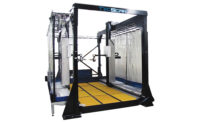NDT Applications: Imaging Ensures Quality of Welds
Founded in 1932, Ledco Ltd. builds progressive and transfer dies used to manufacture metal-stamped structural components for automobiles. With a modern, well-equipped 70,000-square-foot facility in Kitchener, Ontario, Canada, Ledco sells 85% of its production to Tier 1 suppliers in the automotive industry. Doug Morton, quality supervisor is responsible for ensuring that strict QS-9000 quality standards are adhered to in the production of its products.
In order to accurately evaluate the quality of its components, Ledco's metallurgical laboratory uses an imaging system developed by Clemex Technologies of Montreal, Quebec, Canada. Used in conjunction with a stereoscope, the system is comprised of a high-powered PC, Clemex Vision Lite imaging software, and a high-resolution digital camera.
A common application that is frequently performed involves the analysis of component welds.
Measures conducted in the evaluation of welds will play a key role in influencing production processes. The problem that Ledco faced was to accurately measure the depth in which the weld penetrates its parent material and the length over which that depth occurs.
Prior to using the imaging system, an optical comparator was employed to perform this task. "The problem using the traditional method was such that results could be subject to transcription errors and operator fatigue resulting in inaccurate measures-just to name a few," says Morton.
Turning to Clemex, the lab chose to adopt a new method of performing measurements using an imaging system. Before the actual analysis is performed, an elaborate sample preparation procedure is performed.
First, welds are cross-sectioned using industrial grade blades into sizes that can easily be handled. A belt grind is then applied to the surface to be analysed. Polishing of the sample comes next using 800 and 1200 grit paper. In the last step, the sample is etched using a 5% nitol solution, followed by tap water rinsing. After this process is complete, samples are then placed under a stereomicroscope where they can be viewed using a digital camera hook-up.
With an on-screen image, the software instantaneously captures the image. Operators then use interactive measurement tools including the line tool for measuring linear distances and the arc tool for measuring arc lengths. "The nifty line tool is fun to use since it has a ‘caliper' feature which acts like a square-similar to a carpenter's square. Essentially, what this means, is that lines drawn with the line tool can be ‘squared' up to other lines or to known ‘square' features on the part," comments Morton.
"The digital imaging system is unique given that overlaid results are nondestructive," says Morton. "Images can later be saved and archived for viewing at some time in the future. Print-outs using an inexpensive ink-jet printer help us better present our findings thus facilitating communication with our production departments.
"At first, a concern that we had before deciding upon a system to purchase was simplicity," says Morton. "How fast would our team be able to get up and running before they became productive? We were pleasantly surprised, that for those technicians that had a knowledge of working with MS Windows, only a very short period of time was required before they were familiarized with the software's functionality."
Clemex Technologies
(888) 651-6573
Benefits
Decreased inspection time.
The ability to extract accurate results. Archiving of data is possible.
Limited training is required leading to immediate productivity gains.
Looking for a reprint of this article?
From high-res PDFs to custom plaques, order your copy today!



